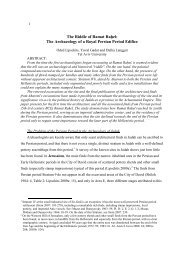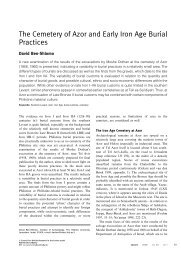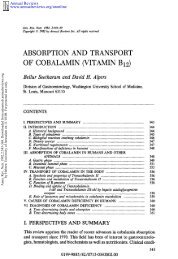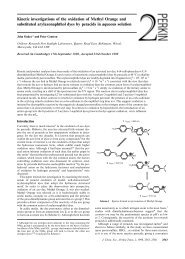520C.L. Vaugh<strong>an</strong> / Journal <strong>of</strong> Biomech<strong>an</strong>ics 36 (2003) 513–523Higher Centreu 0Neural Rhythm Generator•u = q(u)MotorSensoryComm<strong>an</strong>dSignalT r (u) S e (ϕ,F g )(b)Musculo-Skeletal System•ϕ = p(ϕ,F g )(a)ϕEnvironmentF g(c)Fig. 10. (a) A model <strong>of</strong> the locomotor system links control <strong>an</strong>d effect with coupled differential equations (Taga, 1995). Global entrainment <strong>of</strong> theneural system on the one h<strong>an</strong>d, <strong>an</strong>d the musculoskeletal system plus environment on the other, generates <strong>bipedal</strong> gait on (b) the level <strong>an</strong>d c<strong>an</strong> adapt to(c) <strong>an</strong> uphill pathway.coupled differential equations defined both the neuralrhythms (CPGs) <strong>an</strong>d the mech<strong>an</strong>ics <strong>of</strong> the musculoskeletalsystem (cf. Fig. 10a). Once the model had beentrained, it not only produced level gait under normalconditions (cf. Fig. 10b), but it also adapted to environmentalperturbations such as uneven terrain or increasedcarrying load (cf. Fig. 10c). Taga (1995) demonstratedthat the speed <strong>of</strong> <strong>walking</strong> could be controlled by a singleparameter which drove the neural oscillators, <strong>an</strong>d thestep cycle could be entrained by a rhythmic input to theoscillators.7. Robots on two legsPowered dynamic gait in a <strong>bipedal</strong> robot c<strong>an</strong> berealised only through a strategy which is based onstability <strong>an</strong>d real-time feedback controlFive decades ago Isaac Asimov, the science fictionwriter (who also held a doctorate in chemistry)formulated his three laws <strong>of</strong> robotics. The second <strong>of</strong>these stated that ‘‘A robot must obey the orders given itby hum<strong>an</strong> beings’’. One <strong>of</strong> these orders would no doubthave been to walk, a natural extension <strong>of</strong> the originalfunction <strong>of</strong> a ‘‘robot’’, first introduced to the Englishl<strong>an</strong>guage by the playwright Karel Capek in 1921. Basedon his mother tongue <strong>of</strong> Czech, a robota is defined as aworker <strong>of</strong> forced labour. Over 30 years before Capekcoined the term robot, George Fallis in the USAinvented a <strong>bipedal</strong> <strong>walking</strong> toy (Fallis, 1888). Thecentral claim <strong>of</strong> his patent stated ‘‘This inventionconsists <strong>of</strong> a toy which is designed to simulate thehum<strong>an</strong> frame <strong>an</strong>d which is a combined pendulum <strong>an</strong>drocker construction, whereby when placed upon <strong>an</strong>inclined pl<strong>an</strong>e it will be caused by the force <strong>of</strong> its owngravity to automatically step out <strong>an</strong>d walk down thesaid pl<strong>an</strong>e’’ (cf. Fig. 11).What Fallis had described was a passive <strong>bipedal</strong>robot, where the word ‘‘passive’’ connotes the lack <strong>of</strong>active power. Another feature <strong>of</strong> the Fallis walker wasthat its gait was almost certainly static, in the sense thatits centre <strong>of</strong> gravity was always located within its base <strong>of</strong>support. This is in contrast to dynamic <strong>walking</strong> wherethe centre <strong>of</strong> gravity falls outside the support baseduring the tr<strong>an</strong>sition from one foot to the other. Thepassive vs. active debate is <strong>an</strong> interesting one, as is thediscourse on static vs. dynamic gait. A little over 10years ago McGeer (1990) demonstrated that a passivewalker based on the Fallis design, despite the lack <strong>of</strong> <strong>an</strong>yform <strong>of</strong> feedback control, could achieve dynamic gait.His work has led to more recent efforts to explore thepotential <strong>of</strong> passive gait to provide biomech<strong>an</strong>icalinsight (Garcia et al., 1998; Kuo, 2001). The firsttheoretical attempts to describe the mech<strong>an</strong>ics <strong>of</strong> <strong>an</strong>active <strong>bipedal</strong> robot were made over 30 years ago(McGhee, 1968; Vukobratovic, 1970; Fr<strong>an</strong>k, 1970). Agroup at Waseda University in Jap<strong>an</strong>, led by Kato et al.(1974), are generally acknowledged to have been the firstto design <strong>an</strong>d implement a successful active walker.However, it employed a static gait pattern, with active<strong>walking</strong> in a <strong>bipedal</strong> robot only being achieved in thelate 1980s (Zheng, 1989).The most recent breakthroughs in implementingactive dynamic gait in <strong>bipedal</strong> robots have been madeby the Jap<strong>an</strong>ese comp<strong>an</strong>ies Honda (2002) <strong>an</strong>d Sony(2002). Both Honda’s ASIMO (mass 43 kg, height 1.2 m,velocity 0.44 m/s) <strong>an</strong>d Sony’s SDR-3X (mass 5 kg,height 0.5 m, velocity 0.25 m/s) are <strong>an</strong>thropomorphic
C.L. Vaugh<strong>an</strong> / Journal <strong>of</strong> Biomech<strong>an</strong>ics 36 (2003) 513–523 521Fig. 11. The first three drawings <strong>of</strong> the patent by Fallis (1888) demonstrating how a <strong>bipedal</strong> toy is able to walk when powered only by gravity.Reproduced with the permission <strong>of</strong> the United States Patent <strong>an</strong>d Trademark Office. I am indebted to Andy Ruina <strong>of</strong> Cornell University whoseresearch group made the patent available on their web-site.Fig. 12. Two <strong>an</strong>thropomorphic <strong>bipedal</strong> robots, each with 24 degrees <strong>of</strong> freedom, that demonstrate powered dynamic gait utilising real-time feedbackcontrol: (a) ASIMO m<strong>an</strong>ufactured by Honda (2002); <strong>an</strong>d (b) SDR-3X m<strong>an</strong>ufactured by Sony (2002). Both photographs have been reproduced withthe permission <strong>of</strong> the respective comp<strong>an</strong>ies.robots with 24 degrees <strong>of</strong> freedom (cf. Fig. 12). Bothhave joint torque actuators, sophisticated feedback viaaccelerometers <strong>an</strong>d rate sensors, plus <strong>an</strong> onboardcomputer to provide real-time control. As is evidentfrom videos <strong>of</strong> the robots, their gait—which includesstair climbing—is not only stable but very similar to that<strong>of</strong> hum<strong>an</strong>s whom they have been designed to mimic. Tobe sure, robots on two legs have come a long way sinceFallis’ invention in the late 19th century.8. Concluding remarksThere are, <strong>of</strong> course, other import<strong>an</strong>t theories <strong>of</strong>locomotion that have not been considered in this review.These include: the dynamic similarity hypothesis, wherethe Froude number—the dimensionless ratio <strong>of</strong> velocitysquared to the product <strong>of</strong> leg length <strong>an</strong>d the accelerationdue to gravity—is const<strong>an</strong>t (Alex<strong>an</strong>der <strong>an</strong>d Jayes, 1983);the theory <strong>of</strong> the spinal engine, which posits that thelumbar spine is the key structure necessary for l<strong>an</strong>dbasedlocomotion, with the pelvis being driven by thespine (Gracovetsky, 1985); <strong>an</strong>d dynamic systems theory,which postulates that new forms <strong>of</strong> behaviour—such asinf<strong>an</strong>t locomotion—will emerge from the cooperativeinteractions <strong>of</strong> multiple components within a taskcontext (Thelen <strong>an</strong>d Ulrich, 1991). Despite theseomissions, the <strong>odyssey</strong> has covered a wide spectrum,from the evolution <strong>of</strong> <strong>bipedal</strong> <strong>walking</strong> through to theintegration <strong>of</strong> the nervous, muscular, <strong>an</strong>d skeletalsystems.While it is highly unlikely that a single, unifyingtheory <strong>of</strong> <strong>bipedal</strong> <strong>walking</strong> exists, there are interestingways in which the six theories reviewed in this paper







